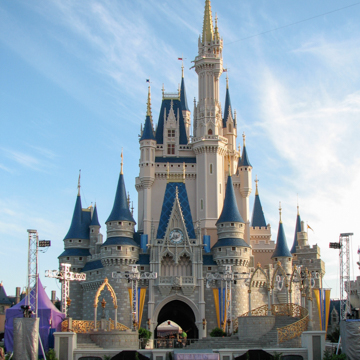Tourism and hospitality have played a central role in the development of Florida, where the warm winters have made it a popular vacation retreat since the mid-nineteenth century. The most popular destination for the state’s roughly 90 million annual visitors is the Walt Disney World Resort, a sprawling constellation of theme parks in the Orlando suburb of Bay Lake. Disney World’s most recognizable icon is Cinderella’s Castle, the central monument of the resort’s oldest theme park, the Magic Kingdom.
The Walt Disney World Resort opened to the public on October 1, 1971. Like Disney Land, its older sibling in Anaheim, California, the Magic Kingdom includes a series of simulated streets, squares, and village settings centered on the turreted towers of a fairy tale castle. The castle provides a landmark to help orient guests throughout the park, and is visible from the entry to the park. This relationship of center and periphery is then repeated in each of the other theme parks (Epcot, Disney’s Animal Kingdom, and Disney’s Hollywood Studios), and then echoed at a larger scale by the relationship of the Magic Kingdom to the resort hotels (the Grand Floridian and Polynesian Village resorts) that ring the lake in front of the park.
In his design for Cinderella’s Castle, Disney Imagineer Herbert Dickens Ryman drew from numerous sources, including his earlier design for Disneyland’s Sleeping Beauty Castle (1955) and the fairy tale residence of the title character in Disney’s 1950 animated film, Cinderella. Ryman studied the details and massing of medieval and Gothic Revival buildings in Europe, such as Castle Neuschwanstein in Bavaria, and synthesized these sources with the building’s animated namesake.
Ryman began working in Hollywood in 1932 (the year he graduated from the Chicago Art Institute), when he took a position as a storyboard illustrator at Metro-Golden-Mayer Studios. He worked on a number of prominent films at MGM, and, significantly for his later career with Disney, designed the Emerald City in The Wizard of Oz. In 1938, he joined Disney and served as art director for Dumbo (1941) and the Pastoral Symphony segment of Fantasia (1940). By 1944, Ryman had left Disney for Twentieth Century Fox, but returned in 1953 to help conceptualize Disneyland. He subsequently designed much of the park’s attractions, and, in 1964, designed the “Great Moments with Mr. Lincoln” spectacle for the New York World’s Fair, which was relocated to Disneyland after the fair closed.
Despite its relatively great height (the tallest tower measures over 180 feet), the building is deceptively small. The interior spaces are limited to a second-floor restaurant (resembling a medieval banqueting hall), a gift shop, and a small guest suite. Five glass mosaic murals depicting scenes from the film decorate the vaulted passageway through the castle. Dorothea Holt Redmond designed the mosaics, as well as other parts of Disney World, and some spaces at Disneyland. (Redmond was a remarkable character who was the first female production designer in Hollywood, worked on seven Alfred Hitchcock films, and spent a decade in the Los Angeles firm of William Pereira and Charles Luckman, where she designed interiors for the Los Angeles County Museum of Art and Los Angeles International Airport.) The playfulness of Redmond’s mosaics continues in other decorative features of Cinderella’s Castle, which include gargoyles resembling characters from the film and a drawbridge (albeit inoperable) that crosses the decorative moat surrounding the building.
References
Marling, Karal A. Designing Disney's Theme Parks: The Architecture of Reassurance. Montréal: Canadian Centre for Architecture, 1997.
Ryman, Herbert D., Bruce Gordon, and David Mumford. A Brush with Disney: An Artist's Journey. Santa Clarita, CA: Camphor Tree, 2000.














